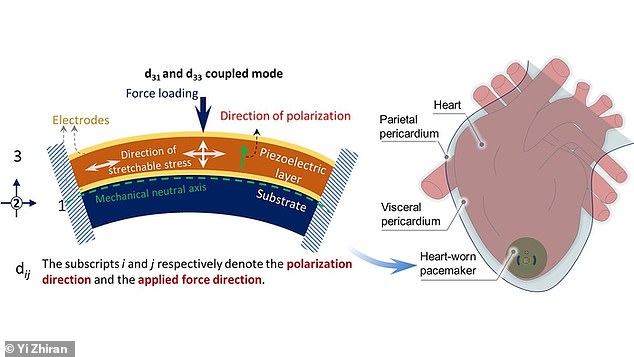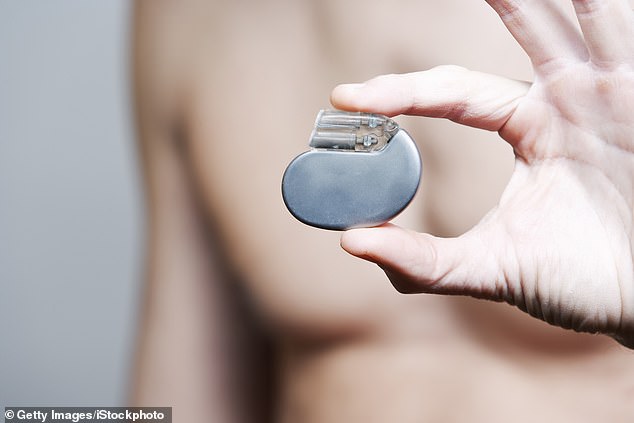Scientists are working on a pacemaker of the future that is battery-free and could be powered by the heart itself.
Typical pacemakers consist of a pulse generator, which has a battery and a tiny computer circuit, and one or more wires known as pacing leads, which attach to your heart.
The pulse generator emits electrical impulses through the wires to your heart and the rate at which they are sent out is called the pacing rate.
The devices are life-saving, but they don’t last forever. Currently, most pacemaker batteries have to be replaced every five to 12 years, and doing so means invasive surgery each time.
However, researchers from Shanghai Jiao Tong University are trying to solve this problem by developing a device that piggybacks off the heart itself to generate energy – meaning a pacemaker battery would never have to be replaced.
Scroll down for video

Scientists are working on a pacemaker of the future that is battery-free and could be powered by the heart itself. At their device’s centre are layers of piezoelectric material, which generate power whenever it is bent
How do traditional pacemakers work?
A pacemaker is a small device about the size of a matchbox or smaller that weighs 20 to 50g.
It consists of a pulse generator, which has a battery and a tiny computer circuit, and 1 or more wires known as pacing leads, which attach to your heart.
The pulse generator emits electrical impulses through the wires to your heart. The rate at which the electrical impulses are sent out is called the pacing rate.
Almost all modern pacemakers work on demand. This means they can be programmed to adjust the discharge rate in response to your body’s needs.
If the pacemaker senses that your heart has missed a beat or is beating too slowly, it sends signals at a steady rate.
If it senses that your heart is beating normally by itself, it doesn’t send out any signals.
Most pacemakers have a special sensor that recognises body movement or your breathing rate.
This allows them to speed up the discharge rate when you’re active. Doctors describe this as rate responsive.
Source: NHS
Advertisement
Yi Zhiran and his team are investing batteryless powering and leadless pacing, but the challenge has been to obtain sufficient power by harvesting heart kinetic energy.
‘If the practical force of the heart is 0.5 newtons, the output power should be about 192 microwatts,’ Yi said.
‘Therefore, for the commercial pacemaker, just about no less than 10 microwatts is sufficient for its normal work.’
A healthy heart can keep time for itself, by way of an internal pacemaker called the sinus node in the upper right chamber.
It fires off an electrical charge some 60 to 100 times a minute, and that electrical energy sets off a series of contractions of heart muscle which in turn pumps blood throughout the body.
But as the heart ages or once it becomes diseased, the sinus node takes a hit, too, and may fail to keep the heart beating in time or at all.
Fortunately, since the late 1950s, we’ve been able to substitute a small, implantable, battery-powered device to send these electrical signals once the heart can’t any more.
Even 60 years later, however, we haven’t figured out what to do about the device’s power supply.
Surgery to place the pacemaker and wires that feed its electrical pulses to the heart is complex, requiring doctors to open the chest cavity.
The pacemaker itself is tucked away in a ‘pocket’ much closer to the skin surface.
Once the battery runs out, usually only a local anesthetic is required to remove the old device and put a new, fully charged one in.
Still, the procedure is an unpleasant hassle that comes with a risk of infection, and it’s expensive to have done.
But Yi and his team now think they have an answer to the problem.
At their device’s centre are layers of piezoelectric material, which generate power whenever they are bent.
Many materials acquire an electrical charge when force is applied to them, including natural ones in our bodies.

Typical pacemakers (pictured) consist of a pulse generator, which has a battery and a tiny computer circuit, and one or more wires known as pacing leads, which attach to your heart
Crystals, DNA and even bone are capable of capturing electrical energy.
The trick is to apply enough force to a piezoelectric material, then supercharge it, because, on their own, these materials don’t work up much energy.
Scientists have long been looking to piezoelectricity as an elegant solution to recapturing otherwise wasted energy, and some have even applied it to the pacemaker before.
But, previously, other researchers have not been able to create a device that bends enough to generate sufficient power.
Yi said: ‘A batteryless pacemaker is feasible through using implantable energy harvesting technology, which provides a sustainable power supply method.’
He and his team are now trying to overcome some drawbacks to the device, such as its long-term stability in the human body, the implanting method, and the integration between the rigid pacing chip and the flexible energy harvesting unit.
‘The first research plan is to achieve the integration of the flexible pacing circuit and the energy harvesting unit. Then, we will carry out the verification of long-term stability in vivo,’ he added.
The presentation ‘Mechanism on Buckled Piezoelectric Energy Harvesting for Batteryless Heartworn Pacemaker’ will be available during the three-day conference.
World’s first wireless, battery-free heart pacing device that DISSOLVES within seven weeks
Scientists have developed the world’s first wireless, battery-free, fully implantable pacemaker that dissolves in the body when it’s no longer needed.
The thin, lightweight device wirelessly harvests energy from a remote antenna, and is made from biocompatible materials that naturally absorb into the body over the course of five to seven weeks.
Researchers behind the device hope it could soon be used in place of temporary pacemakers, which require invasive surgery to remove.
The lightweight device was developed by researchers from Northwestern and George Washington universities, and is believed to be the first-ever transient pacemaker.

The team says that by varying the composition and thickness of the device, they could control the precise number of days it remains functional before dissolving
It wirelessly harvests energy from an external antenna using near-field communication protocols – the same technology used in smartphones for electronic payments and in RFID tags – eliminating the need for bulky batteries and rigid hardware, including wires or leads.
According to the team, this not only reduces the risk of infections, but also the risk of scar tissue.
John A Rogers, who led the study, said: ‘Hardware placed in or near the heart creates risks for infection and other complications.
‘Our wireless, transient pacemakers overcome key disadvantages of traditional temporary devices by eliminating the need for percutaneous leads for surgical extraction procedures – thereby offering the potential for reduced costs and improved outcomes in patient care.
‘This unusual type of device could represent the future of temporary pacing technology.’
Advertisement
Source link : https://www.dailymail.co.uk/sciencetech/article-9860403/Scientists-developing-battery-free-device-future-pacemakers.html











